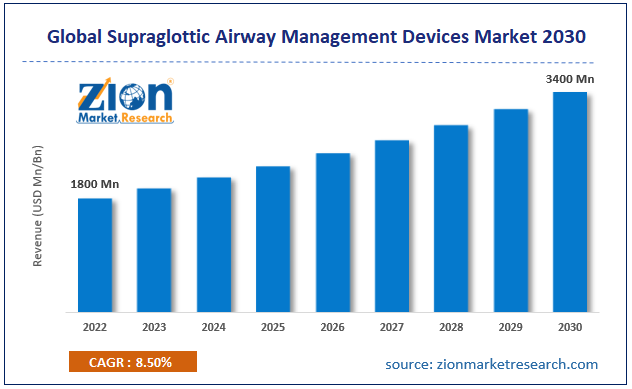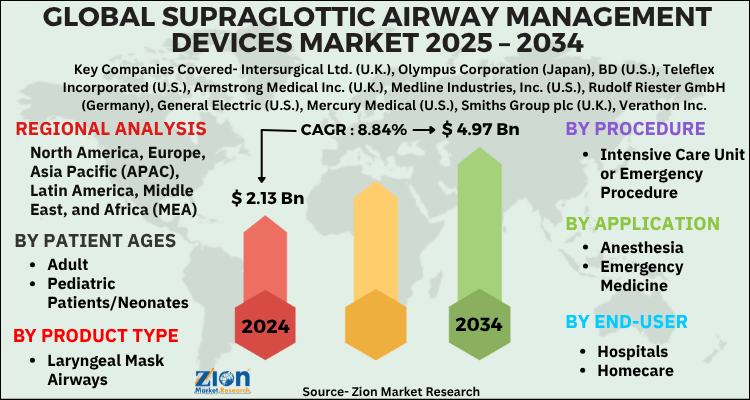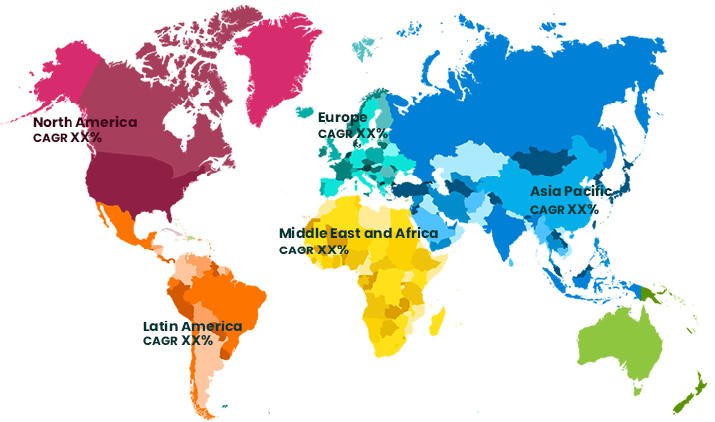Global Supraglottic Airway Management Devices Market Size, Share, Growth Analysis Report - Forecast 2034

Supraglottic Airway Management Devices Market By Patient Ages (Adult, Pediatric Patients/Neonates), By Product Type (Laryngeal Mask Airways, Oropharyngeal Airways, Nasopharyngeal Airways, Others), By Procedure (Intensive Care Unit or Emergency Procedure, Non-Emergency Surgical Procedures), By Application (Anesthesia, Emergency Medicine, Others), By End User (Hospitals, Homecare, Ambulatory Surgical Center, Others), and By Region: Global and Regional Industry Overview, Market Intelligence, Comprehensive Analysis, Historical Data, and Forecasts 2025 - 2034
| Market Size in 2024 | Market Forecast in 2034 | CAGR (in %) | Base Year |
|---|---|---|---|
| USD 2.13 Billion | USD 4.97 Billion | 8.84% | 2024 |
Supraglottic Airway Management Devices Market: Industry Perspective
The global supraglottic airway management devices market size was worth around USD 2.13 Billion in 2024 and is predicted to grow to around USD 4.97 Billion by 2034 with a compound annual growth rate (CAGR) of roughly 8.84% between 2025 and 2034.
The report analyzes the global supraglottic airway management devices market's drivers, restraints/challenges, and the effect they have on the demands during the projection period. In addition, the report explores emerging opportunities in the supraglottic airway management devices industry.
The report analyzes the global supraglottic airway management devices market drivers, restraints/challenges, and the effect they have on the demands during the projection period. In addition, the report explores emerging opportunities in the supraglottic airway management devices industry.
Supraglottic Airway Management Devices Market: Overview
Supraglottic airway management devices (SADs) are medical devices used in anesthesia and emergency medicine to establish and maintain a patent airway during various procedures or resuscitation efforts. These devices are designed to sit above the vocal cords in the supraglottic region of the upper airway, providing a conduit for ventilation and oxygenation. SADs are typically composed of a soft, flexible tube or mask-like structure with an inflatable cuff that helps create a seal around the upper airway structures. They are inserted through the mouth or nose and advanced until the cuff is positioned in the supraglottic space, thereby allowing positive pressure ventilation or oxygenation.
These devices offer several advantages over traditional endotracheal intubation, such as ease of insertion, decreased risk of trauma to the airway, and suitability for patients with difficult airways or limited neck mobility. They are particularly valuable in emergencies or when tracheal intubation is challenging or contraindicated. The global supraglottic airway management devices market has experienced significant growth in recent years and is expected to continue expanding. This growth can be attributed to several factors, including the increasing prevalence of chronic respiratory diseases, advancements in healthcare infrastructure, and the rising demand for minimally invasive airway management techniques.
Key Insights
- As per the analysis shared by our research analyst, the global supraglottic airway management devices market is estimated to grow annually at a CAGR of around 8.84% over the forecast period (2025-2034).
- Regarding revenue, the global supraglottic airway management devices market size was valued at around USD 2.13 Billion in 2024 and is projected to reach USD 4.97 Billion by 2034.
- The supraglottic airway management devices market is projected to grow at a significant rate due to increasing prevalence of chronic respiratory diseases, the rising number of surgical procedures requiring anesthesia, the growing geriatric population, and advancements in device technology offering enhanced safety and ease of use.
- Based on Patient Ages, the Adult segment is expected to lead the global market.
- On the basis of Product Type, the Laryngeal Mask Airways segment is growing at a high rate and will continue to dominate the global market.
- Based on the Procedure, the Intensive Care Unit or Emergency Procedure segment is projected to swipe the largest market share.
- By Application, the Anesthesia segment is expected to dominate the global market.
- In terms of End User, the Hospitals segment is anticipated to command the largest market share.
- Based on region, North America is predicted to dominate the global market during the forecast period.
Supraglottic Airway Management Devices Market: Growth Drivers
The growing geriatric population drives the market growth
The aging population is more prone to respiratory diseases and often requires airway management during surgeries or emergencies. With the increasing elderly population globally, there is a greater demand for supraglottic airway management devices to facilitate safe and efficient airway management in this patient group. For instance, according to the World Health Organization, one in six individuals on the globe will be 60 or older by 2030. By this point, there will be 1.4 billion people over the age of 60, up from 1 billion in 2020. The number of individuals in the world who are 60 or older will double (to 2.1 billion) by 2050. Between 2020 and 2050, the number of people 80 or older is projected to be high, reaching 426 million.
Supraglottic Airway Management Devices Market: Restraints
Lack of training impedes the market growth
While supraglottic airway management devices are generally easier to insert compared to endotracheal intubation, they still require appropriate training and skill for proper placement and optimal patient outcomes. Healthcare providers need to receive adequate training and education on the correct insertion techniques, sizing, and troubleshooting common complications. The requirement for training and skill acquisition can be a barrier to the widespread use of these devices, especially in settings with limited resources or inadequate training programs.
Supraglottic Airway Management Devices Market: Opportunities
The emergence of minimally invasive techniques offers a significant opportunity
There is a growing preference for minimally invasive procedures in healthcare, including airway management. Supraglottic airway management devices offer a less invasive alternative to endotracheal intubation, reducing the risk of complications and trauma to the airway. They are easier to insert, require less expertise, and are associated with shorter procedure times, making them attractive options for clinicians. Therefore, the emergence of minimally invasive techniques is expected to offer a lucrative opportunity for the growth of the supraglottic airway management devices market over the forecast period.
Supraglottic Airway Management Devices Market: Challenges
Lack of standardization poses a major challenge
There is a lack of standardization in terminology, device design, and clinical guidelines for supraglottic airway management devices. The wide variety of available devices with different designs and features can make it challenging for healthcare providers to choose the most appropriate device for specific clinical scenarios. Lack of standardization also hinders comparative studies and evidence-based decision-making, which may impede market growth.
Supraglottic Airway Management Devices Market: Segmentation
The global supraglottic airway management devices industry is segmented based on product, age group, procedure, application, end user, and region.
Based on the product, the global market is bifurcated into laryngeal mask airways, oropharyngeal airways, nasopharyngeal airways, and others. The laryngeal mask airways segment is expected to dominate the market during the forecast period. The segment growth is attributed to its advantages including ease of insertion, reduced trauma and airway damage, and improved patient comfort. LMAs are relatively easy to insert compared to endotracheal tubes. They do not require direct visualization of the vocal cords or extensive training in laryngoscopy. The insertion technique is simpler, making them suitable for both experienced and less-experienced healthcare providers. Moreover, LMA placement involves less manipulation of the airway structures compared to endotracheal intubation. This reduces the risk of trauma to the teeth, lips, tongue, and laryngeal structures, making LMAs a safer option for airway management, particularly in patients with limited neck mobility or unstable cervical spine injuries.
Furthermore, LMAs are generally more comfortable for patients. The device is inserted into the pharynx, sitting above the larynx, and does not require passage through the vocal cords. This avoids irritation of the vocal cords and reduces coughing and sore throat post-procedure. The anatomical design of LMAs also helps in maintaining a more natural breathing pattern and better patient tolerance during anesthesia or sedation. Thereby, driving the segment growth over the forecast period.
Based on the age group, the global supraglottic airway management devices industry is divided into adult and pediatric patients/neonates. The adult age group is expected to capture the largest market share over the forecast period. The growing population and the increased frequency of chronic illnesses among adult patients are held accountable for this. Adult patients who require oxygen and ventilation attend hospitals for medical treatments. Among other fields, anesthesia, emergency care, cardiac resuscitation, and neonatology all employ airway management devices. Additionally, airway management devices are needed because of the rising rate of premature delivery.
Based on the procedure, the market is segmented into intensive care unit or emergency procedures and non-emergency surgical procedures.
Based on the application, the global supraglottic airway management devices industry is bifurcated into anesthesia, emergency medicine, and others.
Based on the end user, the market is segmented into hospitals, homecare, ambulatory surgical center, and others.
Supraglottic Airway Management Devices Market: Report Scope
| Report Attributes | Report Details |
|---|---|
| Report Name | Supraglottic Airway Management Devices Market |
| Market Size in 2024 | USD 2.13 Billion |
| Market Forecast in 2034 | USD 4.97 Billion |
| Growth Rate | CAGR of 8.84% |
| Number of Pages | PagesNO |
| Key Companies Covered | Intersurgical Ltd. (U.K.), Olympus Corporation (Japan), BD (U.S.), Teleflex Incorporated (U.S.), Armstrong Medical Inc. (U.K.), Medline Industries, Inc. (U.S.), Rudolf Riester GmbH (Germany), General Electric (U.S.), Mercury Medical (U.S.), Smiths Group plc (U.K.), Verathon Inc. (U.S.), VBM Medizintechnik GmbH (Germany), SunMed (U.S.), Medtronic (Ireland), Flexicare (Group) Limited (U.K.), VYAIRE (U.S.), Ambu A/S (Denmark), and others. |
| Segments Covered | By Patient Ages, By Product Type, By Procedure, By Application, By End User, and By Region |
| Regions Covered | North America, Europe, Asia Pacific (APAC), Latin America, The Middle East and Africa (MEA) |
| Base Year | 2024 |
| Historical Year | 2020 to 2024 |
| Forecast Year | 2025 to 2034 |
| Customization Scope | Avail customized purchase options to meet your exact research needs. Request For Customization |
Recent Developments:
- In August 2020, a video laryngoscope for use with GlideScope Core airway management devices was introduced by Verathon as the GlideScope Video Baton QC Large.
Supraglottic Airway Management Devices Market: Regional Analysis
North America is expected to dominate the market during the forecast period
North America is expected to dominate the supraglottic airway management devices market during the forecast period. The growth in the region is attributed to the rising prevalence of chronic respiratory disease. For instance, according to the Office of Disease Prevention and Health Promotion, Asthma affects more than 25 million individuals in the US. In addition, COPD (chronic obstructive pulmonary disease), which is one of the leading causes of mortality in the US, affects more than 16 million individuals. Furthermore, there is a growing preference for minimally invasive procedures in North America, including airway management. Supraglottic airway management devices offer a less invasive alternative to traditional endotracheal intubation, reducing patient discomfort and the risk of complications. The demand for minimally invasive techniques contributes to the adoption of supraglottic airway management devices in the region.
The Asia Pacific is expected to grow at the highest CAGR over the forecast period owing to the increasing prevalence of respiratory disease along with growing geriatric populations. For instance, with more than 3.6 million cases, the Indian state of Rajasthan saw the highest incidence of acute respiratory infections in 2021. The second-and third-placed states were Andhra Pradesh and West Bengal, respectively. The danger of these diseases has grown due to India's rising air pollution. Acute respiratory conditions may either be non-communicable like asthma or extremely infectious and fatal like TB. In addition, as per the study by ADB, in Asia and the Pacific, one in four persons will be older than 60 by 2050. Between 2010 and 2050, the number of senior people (those over 60) in the region will quadruple, growing to around 1.3 billion. Thus, the aforementioned facts support the market expansion over the forecast period.
Supraglottic Airway Management Devices Market: Competitive Analysis
The report provides a company market share analysis to give a broader overview of the key market players. In addition, the report also covers key strategic developments of the market, including acquisitions & mergers, new product launches, agreements, partnerships, collaborations & joint ventures, research & development, and regional expansion of major participants involved in the supraglottic airway management devices market on a global and regional basis.
The global supraglottic airway management devices market is dominated by players like:
- Intersurgical Ltd. (U.K.)
- Olympus Corporation (Japan)
- BD (U.S.)
- Teleflex Incorporated (U.S.)
- Armstrong Medical Inc. (U.K.)
- Medline Industries Inc
- (U.S.)
- Rudolf Riester GmbH (Germany)
- General Electric (U.S.)
- Mercury Medical (U.S.)
- Smiths Group plc (U.K.)
- Verathon Inc. (U.S.)
- VBM Medizintechnik GmbH (Germany)
- SunMed (U.S.)
- Medtronic (Ireland)
- Flexicare (Group) Limited (U.K.)
- VYAIRE (U.S.)
- Ambu A/S (Denmark)
The global supraglottic airway management devices market is segmented as follows;
By Patient Ages
- Adult
- Pediatric Patients/Neonates
By Product Type
- Laryngeal Mask Airways
- Oropharyngeal Airways
- Nasopharyngeal Airways
- Others
By Procedure
- Intensive Care Unit or Emergency Procedure
- Non-Emergency Surgical Procedures
By Application
- Anesthesia
- Emergency Medicine
- Others
By End User
- Hospitals
- Homecare
- Ambulatory Surgical Center
- Others
By Region
- North America
- The U.S.
- Canada
- Mexico
- Europe
- France
- The UK
- Spain
- Germany
- Italy
- Rest of Europe
- Asia Pacific
- China
- Japan
- India
- Australia
- South Korea
- Rest of Asia Pacific
- The Middle East & Africa
- Saudi Arabia
- UAE
- Egypt
- Kuwait
- South Africa
- Rest of the Middle East & Africa
- Latin America
- Brazil
- Argentina
- Rest of Latin America
Table Of Content
Methodology
FrequentlyAsked Questions
The global supraglottic airway management devices market is expected to grow due to rising prevalence of respiratory emergencies, increasing surgical procedures, demand for minimally invasive techniques, and advancements in anesthesia administration.
According to a study, the global supraglottic airway management devices market size was worth around USD 2.13 Billion in 2024 and is expected to reach USD 4.97 Billion by 2034.
The global supraglottic airway management devices market is expected to grow at a CAGR of 8.84% during the forecast period.
North America is expected to dominate the supraglottic airway management devices market over the forecast period.
Leading players in the global supraglottic airway management devices market include Intersurgical Ltd. (U.K.), Olympus Corporation (Japan), BD (U.S.), Teleflex Incorporated (U.S.), Armstrong Medical Inc. (U.K.), Medline Industries, Inc. (U.S.), Rudolf Riester GmbH (Germany), General Electric (U.S.), Mercury Medical (U.S.), Smiths Group plc (U.K.), Verathon Inc. (U.S.), VBM Medizintechnik GmbH (Germany), SunMed (U.S.), Medtronic (Ireland), Flexicare (Group) Limited (U.K.), VYAIRE (U.S.), Ambu A/S (Denmark), among others.
The report explores crucial aspects of the supraglottic airway management devices market, including a detailed discussion of existing growth factors and restraints, while also examining future growth opportunities and challenges that impact the market.
RelatedNews
HappyClients
Zion Market Research
Tel: +1 (302) 444-0166
USA/Canada Toll Free No.+1 (855) 465-4651
3rd Floor,
Mrunal Paradise, Opp Maharaja Hotel,
Pimple Gurav, Pune 411061,
Maharashtra, India
Phone No +91 7768 006 007, +91 7768 006 008
US OFFICE NO +1 (302) 444-0166
US/CAN TOLL FREE +1 (855) 465-4651
Email: sales@zionmarketresearch.com
We have secured system to process your transaction.
Our support available to help you 24 hours a day, five days a week.
Monday - Friday: 9AM - 6PM
Saturday - Sunday: Closed







